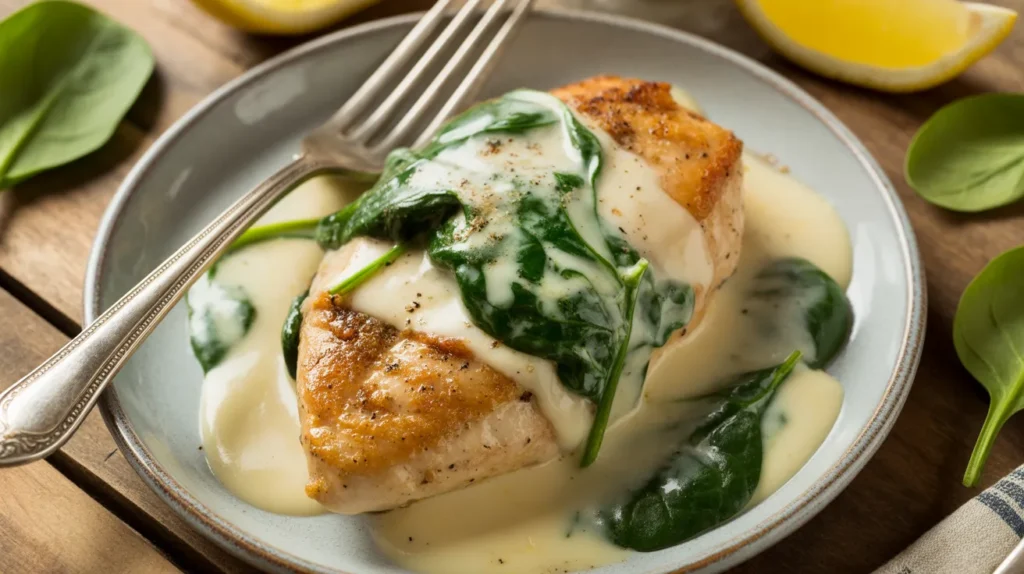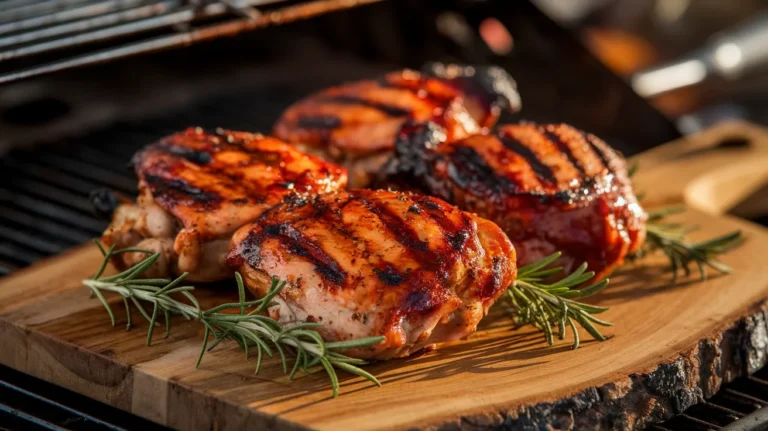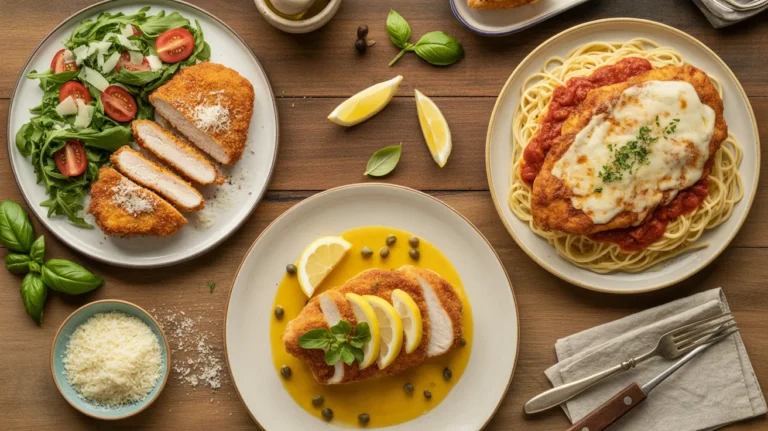This restaurant-quality Chicken Florentine transforms tender chicken breasts into an elegant Italian-inspired dinner with wilted spinach swimming in a velvety cream sauce. Perfect for busy weeknights or special occasions, this Chicken Florentine recipe delivers impressive flavors without the fuss—ready in under 40 minutes with ingredients you probably already have.
SERVES: 4 | PREP: 15 MIN | COOK: 25 MIN | TOTAL: 40 MIN
Ingredients
For the Chicken
| Ingredient | Amount |
|---|---|
| Boneless, skinless chicken breasts | 4 pieces (6-8 oz each) |
| All-purpose flour | ½ cup |
| Salt | 1 teaspoon |
| Black pepper | ½ teaspoon |
| Garlic powder | ½ teaspoon |
| Olive oil | 2 tablespoons |
| Butter | 2 tablespoons |
For the Florentine Sauce
| Ingredient | Amount |
|---|---|
| Garlic cloves, minced | 4 cloves |
| Heavy cream | 1½ cups |
| Chicken broth | ½ cup |
| Fresh spinach | 5 cups (packed) |
| Parmesan cheese, grated | ¾ cup |
| Italian seasoning | 1 teaspoon |
| Red pepper flakes | ¼ teaspoon |
| Lemon juice | 1 tablespoon |
Step-by-Step Instructions
Phase 1: Preparing the Chicken (5 minutes)
Step 1: Take your chicken breasts out of the refrigerator 15 minutes before cooking. Room temperature chicken cooks more evenly and stays juicier. Pat them completely dry with paper towels—any moisture will prevent that golden crust from forming.
Step 2: Place each chicken breast between two sheets of plastic wrap. Use a meat mallet or heavy skillet to pound them to an even ¾-inch thickness. This ensures every piece cooks at the same rate, preventing dry edges and raw centers.
Step 3: Mix your flour, salt, black pepper, and garlic powder in a shallow dish. Whisk these together thoroughly so the seasonings distribute evenly. Set this dredging station right next to your stove for easy access.
Step 4: Dredge each chicken breast in the seasoned flour mixture, pressing gently so the flour adheres to both sides. Shake off any excess—too much flour creates a gummy coating instead of a crispy one.
Phase 2: Searing the Chicken (10 minutes)
Step 5: Heat a large skillet over medium-high heat for 2 minutes. Add the olive oil and butter together. Wait until the butter’s foam subsides—this signals it’s hot enough for a perfect sear without burning.
Step 6: Carefully lay the chicken breasts in the pan, leaving at least 1 inch of space between each piece. Crowding the pan steams the chicken instead of searing it. You’ll hear an immediate sizzle if your pan is properly heated.
Step 7: Let the chicken cook undisturbed for 5-6 minutes. Resist the urge to move or flip them early—a golden-brown crust is forming underneath. The edges will turn opaque about halfway up the sides when they’re ready to flip.
Step 8: Flip each piece using tongs and cook for another 5-6 minutes. The internal temperature should reach 165°F on an instant-read thermometer inserted into the thickest part. Transfer to a clean plate and tent loosely with foil.
Phase 3: Building the Florentine Sauce (10 minutes)
Step 9: Reduce the heat to medium. Add the minced garlic to the same pan without wiping it out—those browned bits are pure flavor. Sauté for 30-45 seconds until fragrant but not browned. Burnt garlic tastes bitter, so watch it closely.
Step 10: Pour in the chicken broth and scrape the bottom of the pan vigorously with a wooden spoon. This deglazing step lifts all those caramelized bits into your sauce, creating incredible depth. Let it bubble for 2 minutes to reduce slightly.
Step 11: Lower the heat to medium-low and add the heavy cream. Stir constantly for 1-2 minutes as it warms through. The sauce will look thin at first but thickens as it simmers.
Step 12: Add the Italian seasoning and red pepper flakes. Stir these aromatics into the cream for 30 seconds so they bloom in the heat and release their essential oils.
Step 13: Add the fresh spinach in three batches, letting each addition wilt down before adding more. It looks like a mountain at first but reduces to about 1 cup wilted. Stir gently until all the spinach turns dark green and silky, about 2-3 minutes total.
Step 14: Sprinkle in the Parmesan cheese while stirring continuously. The sauce will thicken noticeably and turn glossy. If it gets too thick, add a tablespoon of chicken broth at a time until it reaches a pourable consistency.
Step 15: Squeeze in the fresh lemon juice and stir. This brightens the rich cream and cuts through the heaviness perfectly. Taste and adjust seasoning with additional salt and pepper if needed.
Phase 4: Finishing and Plating (2 minutes)
Step 16: Return the chicken breasts to the pan, nestling them into the sauce. Spoon sauce over the tops and let everything warm together for 2 minutes on low heat. This allows the flavors to marry and the chicken to absorb some of that creamy goodness.
Step 17: Transfer each chicken breast to a dinner plate and generously ladle the spinach cream sauce over the top. Garnish with extra Parmesan and a crack of fresh black pepper for restaurant presentation.
Chef’s Notes
Temperature Control: Keep your heat at medium to medium-high when searing. Too hot and the outside burns before the inside cooks; too low and you’ll get pale, rubbery chicken without that gorgeous crust.
Spinach Selection: Baby spinach works beautifully for this Chicken Florentine because it’s tender and wilts quickly. Regular spinach works too but has tougher stems—remove those first. Frozen spinach isn’t ideal here since it releases too much water into your sauce.
Cream Consistency: Heavy cream is non-negotiable for proper texture. Half-and-half will split and look curdled when it reaches high heat. If you’re watching calories, use half heavy cream and half whole milk, but never go below that ratio.
Make-Ahead Magic: You can pound and season the chicken breasts up to 24 hours ahead. Store them covered in the refrigerator, then let them come to room temperature before cooking.
Nutrition Information (Per Serving)
| Nutrient | Amount |
|---|---|
| Calories | 520 |
| Protein | 48g |
| Carbohydrates | 14g |
| Fat | 30g |
| Fiber | 2g |
| Sugar | 2g |
Delicious Variations
Chicken Florentine With Mushrooms: Add 8 ounces of sliced cremini mushrooms after removing the chicken. Sauté them in the pan drippings until golden brown (about 5 minutes), then proceed with the garlic and sauce. The earthy mushrooms complement the spinach beautifully.
Sun-Dried Tomato Twist: Fold in ⅓ cup of chopped sun-dried tomatoes along with the spinach. Their tangy sweetness cuts through the cream and adds gorgeous red flecks throughout the sauce. This variation pairs wonderfully with the flavors you’d find in Chicken Romano, which also features Italian-inspired ingredients.
Chicken Florentine Pasta: Serve your finished chicken over 12 ounces of cooked fettuccine or penne. Toss the pasta directly in the Florentine sauce before plating so every strand gets coated. You’ll need an extra ½ cup of cream and ¼ cup of pasta water to stretch the sauce.
Crispy Prosciutto Version: Before cooking the chicken, crisp 4 slices of prosciutto in the pan until they shatter like bacon. Set aside and crumble over the finished dish for salty, crunchy contrast. This technique also works brilliantly with Chicken Vesuvio, where crispy elements elevate the entire presentation.
Storage & Reheating
Refrigerator Storage: Cool the chicken and sauce completely before transferring to an airtight container. Store for up to 3 days in the refrigerator. Keep the chicken and sauce together so the meat stays moist.
Freezing Instructions: This recipe freezes reasonably well for up to 2 months. Freeze the chicken and sauce in individual portions in freezer-safe containers. The cream sauce may separate slightly upon thawing—whisk in a tablespoon of fresh cream while reheating to bring it back together.
Reheating Methods: For best results, reheat gently in a covered skillet over low heat with a splash of chicken broth or cream. Microwave reheating works in a pinch—use 50% power in 1-minute intervals, stirring the sauce between each round. High heat will make the chicken rubbery and split the cream sauce.
Meal Prep Strategy: Cook the chicken completely but stop before making the sauce. Store the cooked chicken in the fridge for up to 3 days, then make fresh Florentine sauce when you’re ready to serve. The sauce only takes 10 minutes and tastes much better fresh.

Troubleshooting Common Problems
Problem: Dry, Tough Chicken Your chicken overcooked, which happens fast with lean breasts. Invest in an instant-read thermometer and pull the chicken at exactly 165°F. Carryover cooking will bring it up a few more degrees while it rests. Pounding to even thickness also prevents some pieces from overcooking while others finish.
Problem: Watery, Thin Sauce This usually means your spinach released too much moisture or your heat was too low. Always use fresh spinach (not frozen), and make sure your cream is actually simmering—small bubbles should break the surface. Let the sauce simmer an extra 2-3 minutes to evaporate excess liquid, or add an extra tablespoon of Parmesan to thicken it up.
Problem: Grainy or Separated Cream Sauce Your heat got too high or you added cheese too quickly. Cream splits when boiled hard, so keep it at a gentle simmer. Add Parmesan gradually while stirring constantly, never in one big dump. If it’s already separated, remove from heat and whisk in a tablespoon of cold cream to emulsify it again.
Problem: Flour Coating Falls Off During Cooking The chicken was too wet when you dredged it, or your pan wasn’t hot enough. Always pat chicken bone-dry before flouring, and make sure the butter has stopped foaming before adding the chicken—that signals proper temperature. Press the flour firmly onto the chicken so it adheres.
Problem: Burnt Garlic Flavor Garlic burns incredibly fast and turns bitter. Always reduce your heat to medium before adding garlic, and never walk away during this step. Cook it just until fragrant (30-45 seconds maximum). If you accidentally burn it, wipe out the pan completely and start the sauce with fresh garlic.
Equipment Essentials
- Large skillet or sauté pan (12-inch minimum, stainless steel or cast iron preferred)
- Meat thermometer (instant-read digital for accuracy)
- Meat mallet (or heavy skillet for pounding)
- Plastic wrap (for protecting counter while pounding)
- Shallow dishes (for dredging flour station)
- Wooden spoon (for scraping pan and stirring sauce)
- Tongs (for flipping chicken without piercing)
- Measuring cups and spoons
Shopping List
Meat Counter
- 4 boneless, skinless chicken breasts (6-8 oz each)
Dairy Section
- Heavy cream (1 pint)
- Butter (1 stick)
- Parmesan cheese, block or pre-grated (4 oz)
Produce
- Fresh spinach (5 oz package or one large bunch)
- Garlic (1 bulb)
- Lemon (1 whole)
Pantry
- All-purpose flour
- Olive oil
- Chicken broth (1 cup minimum)
- Italian seasoning
- Red pepper flakes
- Salt
- Black pepper
- Garlic powder
Success Secrets
1. Temperature Is Everything Let your chicken sit at room temperature for 15 minutes before cooking. Cold chicken hitting a hot pan contracts and becomes tough. This simple step results in juicier, more tender meat that cooks evenly from edge to center.
2. Don’t Skip the Deglazing Those brown bits stuck to your pan after searing aren’t burnt—they’re concentrated flavor. Scraping them up with chicken broth incorporates all that savory goodness into your sauce. This technique is called deglazing and it’s what separates restaurant-quality dishes from bland home cooking.
3. Fresh Parmesan Makes the Difference Pre-shredded Parmesan contains anti-caking agents that prevent smooth melting and create a grainy sauce. Grate your own from a block right before cooking. It takes 2 minutes and transforms the texture from gritty to silky.
4. Control Your Spinach Add spinach gradually instead of dumping it all at once. This prevents temperature drops that thin your sauce and ensures even wilting. Stir each batch until completely wilted before adding more—it’ll reduce from 5 cups to about 1 cup total.
5. Finish With Acid That squeeze of lemon juice at the end isn’t optional—it’s what makes your Chicken Florentine sing. The acid balances the rich cream and prevents the dish from tasting heavy or one-note. Add it off the heat so the cream doesn’t split from the acidity.




